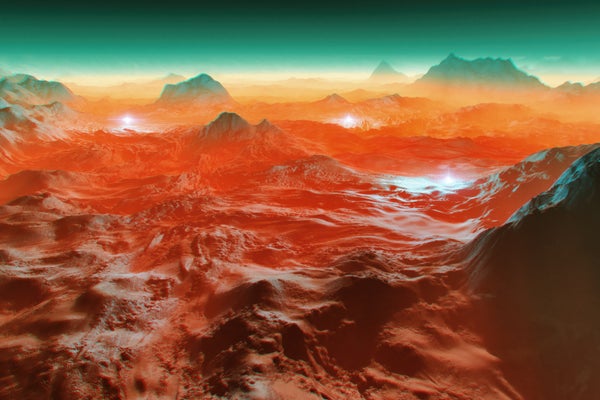September 16, 2024
4 min read
Was Life on Earth Inevitable or Incredible?
We can’t yet tell how life got its start on Earth. That’s one great reason to keep looking for life elsewhere

An imagined exoplanet surface may contain the ingredients for a spark of life.
Two of the most intriguing questions in science are: How did life on Earth begin? and Is there life elsewhere in the universe?
Given the enormous interest in these questions, you might expect that the basic concepts would be settled by now. But in fact, many ideas about crucial aspects of life are plagued with uncertainties and misconceptions. Before we can even crudely estimate the likelihood of life beyond Earth, we need to know a lot more about how life on Earth got started.
Take, for example, the notion that life on Earth emerged out of something called a “primordial soup”—a fluid mix of organic compounds that contained the necessary ingredients for biology. This idea became popular after a famous 1952 experiment by chemists Stanley Miller and Harold Urey, in which the researchers exposed a simple mixture of gases to an electrical spark discharge, and showed they could produce molecules closely related to amino acids. The trial seemed to reproduce a way in which life on Earth might have started. However, a closer examination of their results reveals those sparks created tiny amounts of thousands of different chemicals. Yet more recent research shows that what is really needed for the construction of both RNA (which is responsible for the storage of operational instructions and of information that must be passed on from one generation to the next) and amino acids (the building blocks of proteins) is high concentrations of a just a few key chemicals.
On supporting science journalism
If you’re enjoying this article, consider supporting our award-winning journalism by subscribing. By purchasing a subscription you are helping to ensure the future of impactful stories about the discoveries and ideas shaping our world today.
Another theory frequently publicized in popular science publications is that life on Earth began at relatively low-temperature hydrothermal vents at the bottom of the ocean. Those vents are known to release plumes of alkaline water into the more acidic ocean water, providing a source of energy that is often efficiently harvested by abundant life at the vicinity of these vents. The fact that such environments are heavily colonized by modern life, however, does not imply that they were also the sites of the origin of life. No evidence has ever emerged for any prebiotically plausible chemical reactions that could occur in a deep-ocean hydrothermal vent environment that might lead to the synthesis of the building blocks of RNA (nucleotides), proteins (amino acids) or cell membranes (lipids).
Moreover, cutting-edge origin-of-life research points to the requirement of high concentrations of starting materials—something that cannot be achieved in large oceans, where the necessary chemicals would be diluted and lost. In addition, many of the processes found to be crucial for the origin of life have been shown to require ultraviolet radiation (from the young sun), which provides energy. Such radiation would not have penetrated and reached the bottom of the ocean.
Finally, the origin of life seems to have required various chemical processes to have occurred at different locations and times, to only then come together in the right order. These conditions could have been achieved in small lakes and ponds on the Earth’s surface, where geothermal heat (for example, through lava flows) and wet-dry and freeze-thaw cycles could have created the required variety of conditions, but not at deep-sea locations.
A third misconception (or at least an unresolved problem) concerns opinions about the existence of extraterrestrial life. Astronomical discoveries in the last three decades have shown that our Milky Way galaxy may be teeming with Earth-size planets in the so-called “habitable zone” of their host stars. The habitable zone is that “Goldilocks” range of distances from the central star in which the temperature on the surface of a rocky planet is neither too hot nor too cold for the planet to sustain liquid water (and therefore potentially life) on its surface. The fact that there may be as many as a billion such planets in the Milky Way alone has led many people to assume that there must be extrasolar planets that harbor life. This conclusion, however, is at best premature. Since we have not yet discovered any life outside of Earth, we have no idea of the probability of life emerging on a planet, even if the conditions are propitious. In particular, the latest findings from origins-of-life research suggest that distinct geochemical scenarios need to be linked together in the right sequence to produce the building blocks of life simultaneously in the same place.
To give just one example, compounds of iron and cyanide (ferrocyanides) have been found to be crucial for producing the nucleotide building blocks of RNA. Reservoirs of such ferrocyanide salts could have undoubtedly formed on the early Earth (through iron from Earth’s crust linking up with cyanide from Earth’s atmosphere, and ferrocyanide salts precipitating out above a certain concentration). These reservoirs, however, might also have been readily washed away or altogether destroyed. Consequently, the probability of a local accumulation of ferrocyanide salts surviving to the point of it being able to participate in the subsequent steps required to make the molecules of life might have been very low. Moreover, other necessary compounds had to be delivered in a particular order to those environments in which the succeeding steps could take place. At the moment, we cannot even estimate the probability for the entire sequence of steps to occur, so it is impossible to conclude whether the appearance of life on Earth was inevitable, or an incredibly unlikely chemical accident. The question about the existence (or not) of extraterrestrial life in the Milky Way may therefore be answerable only via an aggressive astronomical search for life itself.
This is an opinion and analysis article, and the views expressed by the author or authors are not necessarily those of Scientific American.

